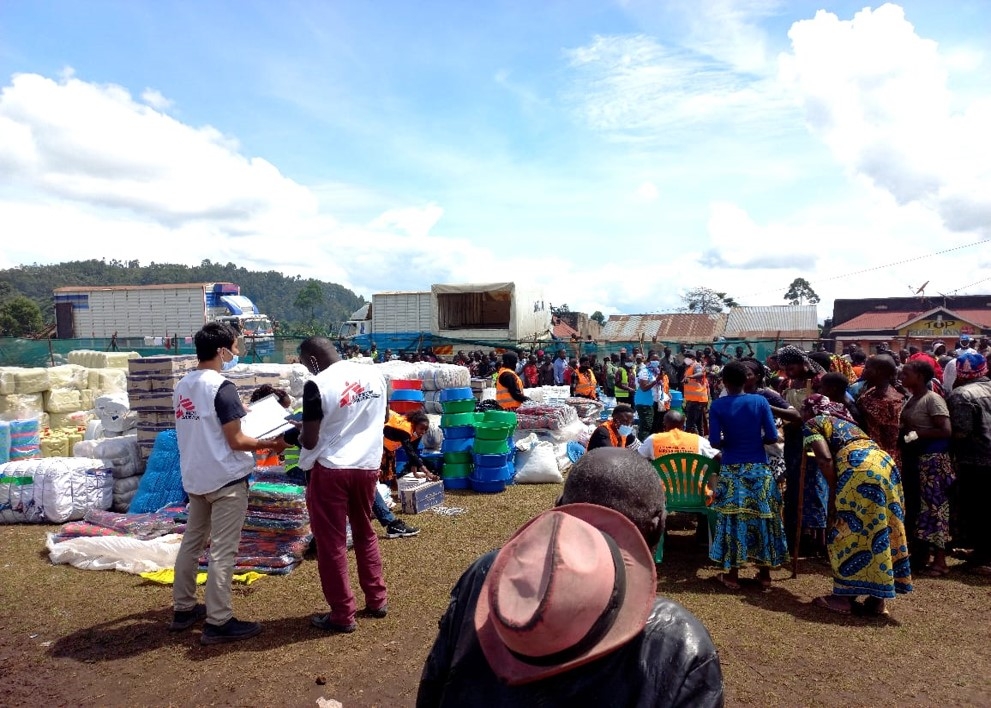Following clashes between M23 rebel group and the Congolese army in North Kivu province in Democratic Republic of Congo, 25,000 to 30,000 people have sought refuge in neighbouring Uganda, with more than 18,000 refugees sheltering in Nyakabande holding camp. A team from Médecins Sans Frontières/Doctors Without Borders (MSF) has been providing emergency medical and humanitarian assistance in the camp since April. Despite our intervention, the needs remain big for these people who are waiting to return to their country.
On March 28, 2022, clashes took place between the Congolese army (FARDC) and the M23 rebel group in Rutshuru territory (located in North Kivu, Democratic Republic of Congo). Over three days, at least 45,000 people were forced to hastily abandon their homes and villages.
"After staying for some time in the border town of Bunagana, hoping to return home quickly, many of these people were forced to Nyakabande camp, a former refugee holding camp located 17 km from the border," says Theo Wanteu, MSF's head of mission in Uganda.
With initial space for 1,000 people, the camp was expanded by the Ugandan government and the UN Refugee Agency (UNHCR) to accommodate an additional 5,000 people, but now shelters more than three times that number.
"With an average of 300 arrivals per day, the camp remains grossly undersized and today 18,000 people are crammed into it, 60 per cent of them children,” says Wanteu. “In this overcrowded camp, people’s needs quickly drew the attention of our team and we launched our response on 4 April."
The MSF teams started by setting up a health centre where they now provide some 300 outpatient consultations per day. Many patients have malaria or respiratory diseases, which is widespread in the camp due to people’s basic living conditions, the high altitude and the rainy season. MSF medics also provide mental healthcare, antenatal consultations, malnutrition treatment and care for survivors of sexual violence. MSF has set up a 22-bed inpatient ward next to the health centre to treat the most severe cases requiring continuous hospitalization.
Within the camp, 15 per cent of children under five are malnourished, 13 per cent with moderate acute malnutrition and 2.5 per cent with severe acute malnutrition, according to data from Medical Teams International (MTI), another organisation working in the camp.
Poor sanitation in the camp raises a significant risk of cholera. To prevent this, MSF helped organise a vaccination campaign for more than 11,500 people, both in the camp and in the nearby town of Kisoro, and the team is ready to respond to any epidemic emergencies.
To improve living conditions and reduce the risk of epidemics breaking out, MSF water and sanitation engineers have built 210 latrines. However, with just one latrine for 64 people, minimum standards for emergencies have not yet been met.

Distribution of non-food items to 5,000 people in Nyakabande holding camp [© Théo Wanteu/MSF ]
The MSF team has distributed essential relief items, including jerrycans, mats, soap, blankets, buckets and sanitary pads, to more than 5,000 people. The team has also set up 20 tents, each able to accommodate 100 people. They are ready to install 40 more tents if needed.
"Our emergency response was planned to last for two months, allowing time for other humanitarian organisations to come and provide the refugees with the support they need,” says Wanteu. “However, the response by other organisations is not yet meeting people’s needs, so we have decided to continue our support for the time being."
On the other side of the border, in the territory of Rutshuru (Democratic Republic of Congo), the needs of people who have been forced to leave their villages are also numerous in terms of access to basic needs (health care, food, water, shelter, etc.). In the areas around Mungo and Rutsiro, where 25,000 internally displaced persons live, our teams have donated medicines to health centers, set up primary health care consultations and begun to build latrines and showers.
![300 outpatient consultations are performed every day at the MSF clinic in Nyakabande holding camp [© Théo Wanteu/MSF ] 300 outpatient consultations are performed every day at the MSF clinic in Nyakabande holding camp](/sites/default/files/styles/hero_desktop/public/msfimages/news/msb125337_medium.jpg?itok=-40KPshC)